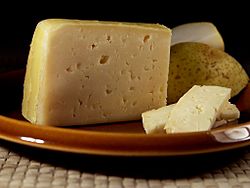Tilsit cheese facts for kids
Quick facts for kids Tilsit |
|
|---|---|
 |
|
| Other names | Tilsit cheese, Tilsiter cheese |
| Country of origin | Prussia / German Empire |
| Region | East Prussia (today's Kaliningrad Oblast) |
| Town | Tilsit (today's Sovetsk) |
| Texture | semi-hard |
| Certification | Holsteiner Tilsiter PGI (Dec. 2013) |
Tilsit cheese or Tilsiter cheese is a light yellow, semi-hard cheese. It has a special rind that is washed during its making. This helps it get its unique flavor. This cheese was first made in the mid-1800s.
It was created by a family from Switzerland, the Westphals. They were settlers who moved to Prussia. The original buildings where they made this cheese can still be seen today in a town called Sovetsk, Russia. This town used to be known as Tilsit.
Contents
How Tilsit Cheese Was Born
When the Westphal family moved to Tilsit, they found that the ingredients for making cheese were different from their home country. The climate was also more humid. Because of these changes, new types of tiny living things like molds, yeasts, and bacteria grew on the cheese.
This made the cheese taste much stronger and richer. The settlers decided to name this new, special cheese after the town where they lived, Tilsit.
What Tilsit Cheese Looks Like and Tastes Like
Tilsiter cheese has a texture that is medium-firm. It often has small, uneven holes or cracks inside. Most Tilsiter cheese sold today is made from cow's milk that has been pasteurized. This means the milk has been heated to kill any harmful germs.
The cheese usually has a dark yellow rind. It can have different amounts of fat, from 30% to 60%. After it's made, the cheese needs to rest for about two more months to get its full flavor.
Sometimes, Tilsiter cheese is flavored with caraway seeds or peppercorns. It goes very well with hearty breads like rye bread and dark beers. It's a popular cheese to eat at the table, but it's also very useful in cooking. You can cut Tilsit into cubes for salads, melt it into sauces, or put it on potatoes, in flans, or on burgers.
Tilsit Cheese Around the World
The original recipe for Tilsiter cheese was brought back to Switzerland. People there have been making it since 1893. In Germany, it has been made since 1920. In Germany, it is known by a special protected name, Holsteiner Tilsiter. This means only cheese made in a certain way in that region can use the name.
Swiss Tilsiter comes in three main types:
- A mild version (green label) made from pasteurized milk.
- A stronger-flavored version (red label) made from fresh, unpasteurized milk.
- A yellow-labeled "Rahm-Tilsiter" made from pasteurized milk with extra cream added.
After World War II, the town of Tilsit became part of Russia. It is now called Kaliningrad Oblast. Even after this change, Tilsiter-style cheeses continued to be made in Switzerland and Germany.
Today, Tilsit cheese is made in many other countries too. These include Australia, Finland, Estonia, Latvia, Lithuania, Poland, Romania, Russia, and Ukraine. You can also find it for sale in the USA.
See also
 In Spanish: Queso Tilsit para niños
In Spanish: Queso Tilsit para niños

